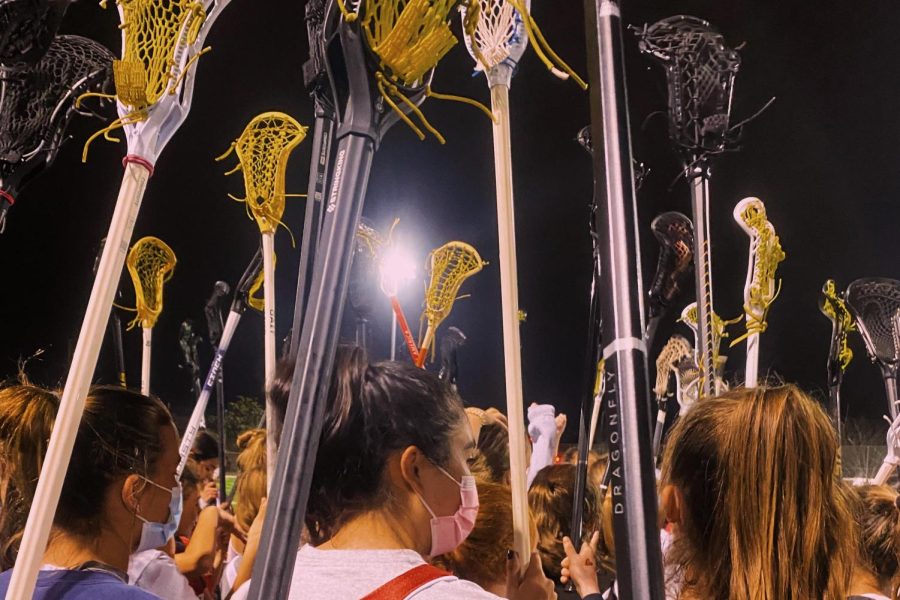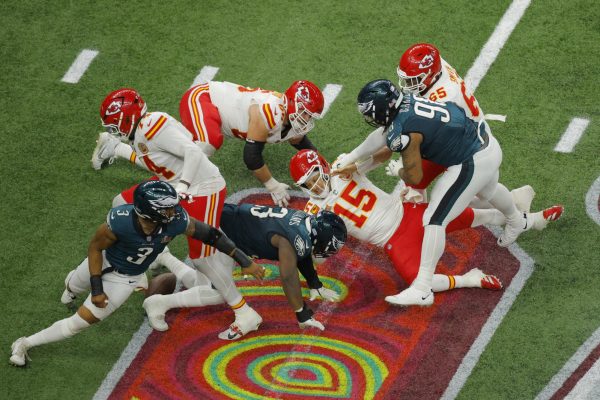Managing athletic injuries: High school, collegiate concussion protocols, injury awareness
Photo credit: Claire Doyle
Club lacrosse team Fire Lacrosse holds up sticks to cheer after a practice at John Adams Middle School. High school soccer goalie and club volleyball player Serenity Jones-Nwankwo said she has played through and not been fully honest about her injuries because she would rather play hurt than not play at all.
“How many fingers am I holding up?” “Are you dizzy?” “Nauseous?” These are all questions used to diagnose concussions in athletes.
According to Stanford Medicine, of the 30 million children and teenagers who participate in sports, 3.5 million of them get injured annually, and the leading cause of death in adolescent sports is brain injury. With the amount of injuries occurring in adolescent sports, injury — and especially concussion — protocols are crucial for the safety of athletes.
Injury Protocols in School and Club Environments
Archer uses Impact Applications, a concussion test to determine student-athletes’ baseline abilities to remember shapes, colors, numbers and more. All students who participate in Archer sports team are required to take the concussion test prior to their season.
When athletes are suspected of having a concussion, they retest to determine the severity of the concussion. The test measures changes in memory, attention span and visual and verbal problem solving. If the athlete scores far lower than the original baseline test, the test score is reported to the student’s doctor for them to suggest the best course of action.
According to a study performed by Safe Kids Worldwide, 53% of high school and adolescent sports coaches have felt pressure to put injured players back into the game. 42% of high school players have down-played or hidden injuries.
The California Interscholastic Federation manages high school sports for both public and independent schools. The CIF maintains a protocol that ensures athletes’ health by requiring pre-season doctors visits and coaches to carry first aid kits.
Freshman Serenity Jones-Nwankwo is a multisport athlete who has played club volleyball, soccer and track for Archer. She attributed the way injuries are dealt with to the differing coaching types. She said that while some coaches are hyper-vigilant of athletes’ health, others want the most out of each player, even if that means playing through injuries.
“I feel like it depends on the coach,” Jones-Nwankwo said. “Some coaches make you push through it because they don’t believe you’re hurting as much as you are, which can be frustrating.”
Jones-Nwankwo also said that athletes view injury as something that can hinder their college recruitment process.
“I think they’re taken more seriously in club because that’s usually where recruits are. If you want to play in college or anything like that, club are where scouts are. Whereas for school, they don’t really have scouts or anything here, so they just let you play,” Jones-Nwankwo said.
According to Next College Student Athlete College Recruiting, sports injuries should not play a major role in the recruiting process as long as there is an open line of communication to college coaches about the severity of the injury and the setbacks it has caused. This honesty is just as important in a high school setting because it prepares athletes for a career in college.
Athletic Director Kim Smith played Division I soccer at the University of Virginia before playing professional soccer in Germany, Japan and multiple U.S. states. Smith said that sports medicine and protocols have evolved since she was a player. To make sure that Archer athletes are protected from head injuries like many professional athletes later suffer, Smith ensures that Archer athletes follow concussion protocol.
“We have a concussion protocol, so making sure that all of the trainers follow that, so, if there’s a head injury, and if they don’t pass it, they don’t play and making sure that the athletes health comes first,” Smith said.
To listen to Smith talking about her own experiences with injuries, listen to the audio below.
Importance of Transparency in Collegiate Sports
According to the Guardian, of the 500,000 collegiate athletes recognized by the NCAA, there are 210,000 injuries annually ranging from minor to fatal.
Vaughan Anoa’i (’22), an Archer alumni and a freshman at Georgetown University, played her seventh year of volleyball and first year at the collegiate level. Anoa’i has played high school, club and Division I volleyball and said there is a hyper focus on the health and mobility of athletes at the collegiate level.
“In college, there is a lot of thought that goes into the exercises that we’re doing, whether that’s when we’re weightlifting or during practice,” Anoa’i said in a phone interview. “And a lot of these are geared toward injury prevention just because we have such a rigorous playing schedule, especially during season. It’s incredibly important to preserve our bodies.”
Anoa’i said that she believes high schools athlete often do not take their injuries seriously and do not inform their coaches and trainers. She said this can can lead to further, more long-term injuries.
“When I’ve had minor injuries in the past, [pushing through injuries] has always been encouraged. Not so much by my coaches, but when you play at such a high level and are in such a competitive club environment, you are encouraged to push through for your teammates and for yourself,” Anoa’i said. “But in college, they do stress the importance of being honest with your coaches, being honest with the trainer if something is bothering you.”
Smith said that injuries may stem from athletes’ intense love for their sport and their unwavering commitment to playing in every game, even when they are not in adequate physical or mental condition. For many athletes with serious injuries, they are forced to sit out of games and sometimes a full season. Therefore, playing through minor injuries was expected for Smith and her teammates.
![Archer swimmers dive into Crossroads pool for their seventh meet of the season. " it [sports] has kind of conditioned me. If I get scraped my knee or something else to complain about, I just keep moving on." Jones said.](https://archeroracle.org/wp-content/uploads/2023/04/big-story-475x317.jpg)
Both Smith and Anoa’i said that athletes’ tools are their bodies and stressed the importance of being able to use them for a long time.
“For me, as a freshman, you still have to be able to play for three more years,”Anoa’i said. “It’s not so much a one-and-done, and then you’re able to have a really long break.”
Anoa’i said people should focus on the prevention of major injuries rather than the inevitable nature of sports injuries.
“Sports injuries within sports are definitely inevitable, especially when your body is the main vehicle when you’re able to play. Some days are going to be physically more taxing and more draining than others,” Anoa’i said. “So, I think a lot of the times people will overlook sports injuries like, ‘Oh, they’re going to happen,’ but I do think that there needs to be more of an emphasis placed on injury prevention.”
With advancements in technology and an increased understanding of the body, collegiate and high school athletes can be now better prepared and treated.
“We know so much more about the human body and have the resources and technology to be able to meet the athletes where they are, and to help them get to where they need to be and want to be,” Smith said.

Claire Doyle joined the oracle as a staff reporter in 2022. She plays club lacrosse as well as swims for Archer. She was captain of Archer's middle school...








![Laila Boodell ('28) gently hugs her show horse, Calvin, while on a walk around her barn. "[Calvin] is gigantic, but he's like a little puppy," Boodell said. "He's insanely obedient."](https://archeroracle.org/wp-content/uploads/2025/02/MG_0073-600x400.jpg)

Allegra Carney • May 24, 2023 at 2:18 pm
So proud of you Claire!! Such a great article!